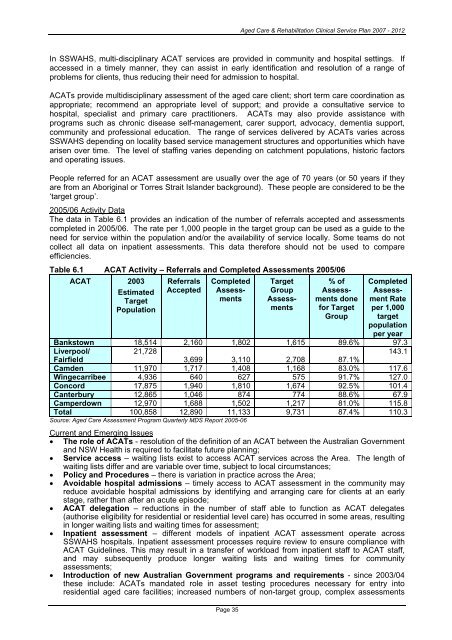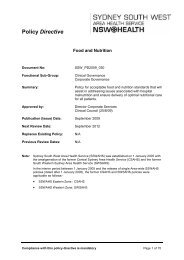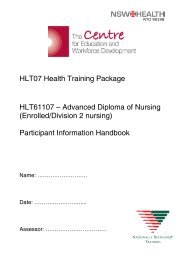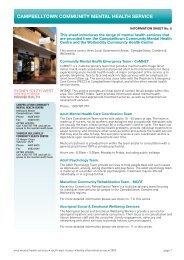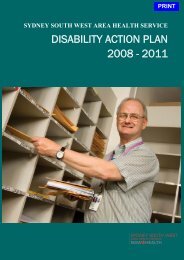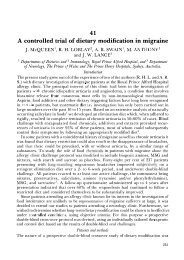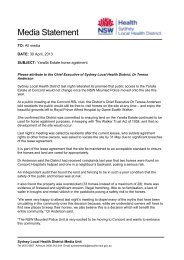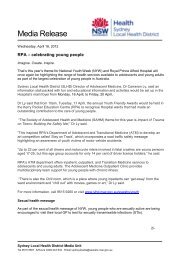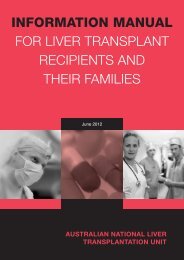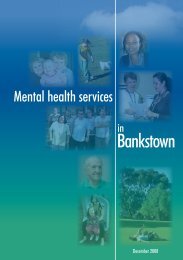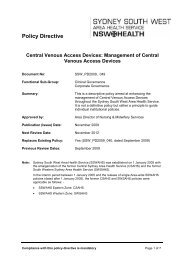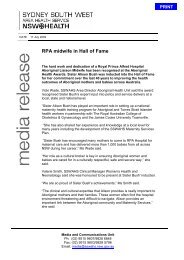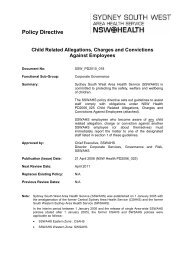Aged Care & Rehabilitation Clinical Services Plan 2007 – 2012
Aged Care & Rehabilitation Clinical Services Plan 2007 – 2012
Aged Care & Rehabilitation Clinical Services Plan 2007 – 2012
Create successful ePaper yourself
Turn your PDF publications into a flip-book with our unique Google optimized e-Paper software.
<strong>Aged</strong> <strong>Care</strong> & <strong>Rehabilitation</strong> <strong>Clinical</strong> Service <strong>Plan</strong> <strong>2007</strong> - <strong>2012</strong>In SSWAHS, multi-disciplinary ACAT services are provided in community and hospital settings. Ifaccessed in a timely manner, they can assist in early identification and resolution of a range ofproblems for clients, thus reducing their need for admission to hospital.ACATs provide multidisciplinary assessment of the aged care client; short term care coordination asappropriate; recommend an appropriate level of support; and provide a consultative service tohospital, specialist and primary care practitioners. ACATs may also provide assistance withprograms such as chronic disease self-management, carer support, advocacy, dementia support,community and professional education. The range of services delivered by ACATs varies acrossSSWAHS depending on locality based service management structures and opportunities which havearisen over time. The level of staffing varies depending on catchment populations, historic factorsand operating issues.People referred for an ACAT assessment are usually over the age of 70 years (or 50 years if theyare from an Aboriginal or Torres Strait Islander background). These people are considered to be the‘target group’.2005/06 Activity DataThe data in Table 6.1 provides an indication of the number of referrals accepted and assessmentscompleted in 2005/06. The rate per 1,000 people in the target group can be used as a guide to theneed for service within the population and/or the availability of service locally. Some teams do notcollect all data on inpatient assessments. This data therefore should not be used to compareefficiencies.Table 6.1 ACAT Activity – Referrals and Completed Assessments 2005/06ACAT 2003 Referrals Completed Target % of CompletedEstimated Accepted AssessmentsAssessmentsdone ment RateGroup Assess-Assess-TargetPopulationments for Target per 1,000Group targetpopulationper yearBankstown 18,514 2,160 1,802 1,615 89.6% 97.3Liverpool/21,728143.1Fairfield3,699 3,110 2,708 87.1%Camden 11,970 1,717 1,408 1,168 83.0% 117.6Wingecarribee 4,936 640 627 575 91.7% 127.0Concord 17,875 1,940 1,810 1,674 92.5% 101.4Canterbury 12,865 1,046 874 774 88.6% 67.9Camperdown 12,970 1,688 1,502 1,217 81.0% 115.8Total 100,858 12,890 11,133 9,731 87.4% 110.3Source: <strong>Aged</strong> <strong>Care</strong> Assessment Program Quarterly MDS Report 2005-06Current and Emerging Issues• The role of ACATs - resolution of the definition of an ACAT between the Australian Governmentand NSW Health is required to facilitate future planning;• Service access – waiting lists exist to access ACAT services across the Area. The length ofwaiting lists differ and are variable over time, subject to local circumstances;• Policy and Procedures – there is variation in practice across the Area;• Avoidable hospital admissions – timely access to ACAT assessment in the community mayreduce avoidable hospital admissions by identifying and arranging care for clients at an earlystage, rather than after an acute episode;• ACAT delegation – reductions in the number of staff able to function as ACAT delegates(authorise eligibility for residential or residential level care) has occurred in some areas, resultingin longer waiting lists and waiting times for assessment;• Inpatient assessment – different models of inpatient ACAT assessment operate acrossSSWAHS hospitals. Inpatient assessment processes require review to ensure compliance withACAT Guidelines. This may result in a transfer of workload from inpatient staff to ACAT staff,and may subsequently produce longer waiting lists and waiting times for communityassessments;• Introduction of new Australian Government programs and requirements - since 2003/04these include: ACATs mandated role in asset testing procedures necessary for entry intoresidential aged care facilities; increased numbers of non-target group, complex assessmentsPage 35


